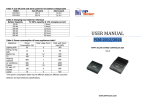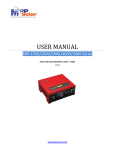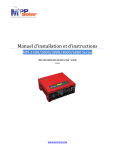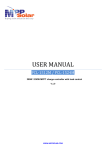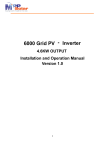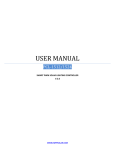Download USER MANUAL - E
Transcript
Table 4: Cutoff & Alarm points for battery voltage table Model PCM-3012 PCM-3024 LVD 10.0 V 20.0 V Low Alarm 10.5 V 21.0 V LVR 12.0 V 24.0 V HVD 15.0 V 30.0 V HVR 13.0 V 26.0 V Table 5: Charging hour table for reference Battery Capacity To 90% capacity @ 25A charging current 52 Ah 2 hours 100 Ah 4 hours 200 Ah 8 hours 300 Ah 12 hours 400 Ah 16 hours 500 Ah 20 hours Table 6: Power consumption of home appliances table* Appliances Lighting bulb Energy saving bulb Electric fan TV Washing machine Air conditioner Freezer PC with 17” monitor Laptop Power Consumption (W) 60 Daily usage hours 6 Daily watt hours used (Wh) 360 13 6 78 60 100 12 4 720 400 800 1 800 800 400 6 24 4800 9600 150 6 900 70 6 420 USER MANUAL PCM-3012/3024 MPPT SOLAR CHARGE CONTROLLER 25A V.1.0 *This power consumption table may be different based on different consumer behavior and local electronic specifications. WWW.MPPSOLAR.COM 1. Introduction PCM-3012/3024 MPPT solar charge controller uses PWM-based DSP controller to keep the batteries regulated and prevent batteries from overcharging and discharging. Applying intelligent MPPT algorithm, it allows the controller to extract maximum power from solar arrays by finding the maximum power point of the array. The solar charge controller facilitates a standalone energy system. Typical application includes: Mobile applications such as moving van, lodge, log cabin, or night market. Lighting applications such as street lights, road lights, or garage lights. Remote village with power shortage 2. Product Overview 3. Installation Inspection Remove the unit from the shipping package and inspect it for damage that may occur during transportation. Notify the carrier and place of purchase if any damage is found. Installation Note Power switch Solar energy status indicator (Blue LED) Charging status indicator (Green LED) Site wiring fault indicator (Red/Orange/Yellow LED) LCD display (see Operation Section for the details) Terminal block for solar panel connection Terminal block for battery connection Terminal block for load connection Read all the installation section before beginning installation CAUTION! Careful to reduce the risk or dropping a metal tool on the batteries. It could spark or short circuit the batteries and could cause an explosion. CAUTION! Remove personal metal items such as rings, bracelets, necklaces, and watches when working with batteries. Batteries can produce a short circuit current high enough to make metal melt, and could cause severe burns. CAUTION! Avoid touching eyes while working near batteries. CAUTION! Have plenty of fresh water and soap nearby in case battery acid contacts skin, clothing, or eyes. Explosive battery gases may be present during charging. Be certain there is sufficient ventilation to release the gasses. CAUTION! NEVER smoke or allow a spark or flame in vicinity of a battery. Do not expose this charger controller to rain, snow or liquids of any type. WARNING! Provide ventilation to outdoors from the battery compartment. The battery enclosure should be designed to prevent accumulation and concentration of hydrogen gas at the top of the compartment. CAUTION! Use insulated tools to reduce the chance of short-circuit when installing or working with the inverter, the batteries, or other equipments attached to this unit. CAUTION! For battery installation and maintenance, read the battery manufacturer's installation and maintenance instructions prior to operating. Only charge Sealed Lead Acid, Vented Lead, NiCd or Gel batteries. CAUTION! To reduce risk of injury, only use qualified batteries from qualified distributors or manufacturers. Any unqualified batteries may cause damage and injury. Do NOT use old or overdue batteries. Please check the battery type and date code before installation to avoid damage and injury. WARNING! It's very important for safety and efficient operation to use appropriate external battery cable. To reduce risk of injury, external cables including battery cables, PV panel cables and load connected cables should be UL certified and rated for 75° C or higher. And strongly suggest not to use copper cables less than 12AWG. Below is the external battery cable reference according to system requirements. Model Nominal Battery Voltage Typical Current (Amp) PCM-3012 12 V 25 A PCM-3024 24 V 25 A NOTE: It's recommended to allow experienced personnel to install solar panel because the efficiency of solar energy transmission is directly affected by installation angles. Please follow the voltage requirement of the unit to wire connection with solar panel and batteries Mounting Step 1: Choose mounting location Locate the solar charger controller on a vertical surface. Select an appropriate mounting location. Use a horizontal line and the length of the line must be 150mm and mark the two ends on the wall. (see Fig. 1 & Fig. 3) Step 2: Check the clearance Install the solar charge controller in a protected area that is free of excessive dust and has adequate air flow. Please place the solar charge controller away from other units at least 20 cm to avoid interference. Do NOT operate it where the temperature and humidity is outside the specific limits. (Please check the specs for the limitations.) Step 3: Drill the holes Remove the controller and drill 2 holes in the marked locations with 2 screws. Step 4: Secure controller Place the unit on the surface and align the mounting holes with 2 screws in step 3. (see Fig. 2 & Fig. 4) Wiring CAUTION! Be sure to secure all wiring, especially for mobile applications. Use cable clamps to prevent cables from swaying when the vehicle is in motion. Unsecured cables create loose and resistive connections which may cause excessive heating or fire Step 1: DC Load Wiring The load output will provide battery voltage to connected loads such as lights, monitors and other electronic devices. Wall Step 1: connect load positive (+) wire to the positive terminal of the unit and load negative (-) wire to the negative terminal of the unit. Step 2: install a DC Breaker or a DC fuse holder in a positive wire. The rating of the DC Breaker/Fuse must be according to the charging current (40 Amp). Keep the DC breaker off or do not install the DC fuse. Fig. 1 Fig. 2 WARNING! Please use the appropriate cable size according to load rating. Please refer to Important Safety Warnings Section for the details. It will prevent internal high temperature. Step 2: Battery Wiring Fig. 3 Fig. 4 Step 1: connect battery positive (+) wire to the positive terminal of the unit and load negative (-) wire to the negative terminal of the unit. Step 2: install a DC Breaker or a DC fuse holder in a positive wire. The rating of the DC Breaker/Fuse must be according to the charging current (40 Amp). Keep the DC breaker off or do not install the DC fuse. 1) Multiple batteries in series connection (Refer to Fig. 5): All batteries must be equal in voltage and amp hour capacity. The sum of their voltages must be equal to the nominal DC Voltage of the unit. 2) Multiple solar modules in series connection (Refer to Fig. 8): All modules must be equal in voltage and amp hour capacity. The sum of their voltages must be equal to the nominal DC Voltage of the unit. And, the sum of their solar power must not exceed the maximum capacity of the unit. Fig. 5 2) Multiple batteries in parallel connection (Refer to Fig. 6): Each battery's voltage must be equal to the Nominal DC Voltage of the unit. Fig. 8 3) Multiple solar modules in parallel connection (Refer to Fig. 9): Each module's voltage must be equal to the Nominal DC Voltage of the unit. And, the sum of their solar power must not exceed the maximum capacity of the unit. Fig. 6 Step 3: Solar Module Wiring WARNING: Risk of electric shock! Exercise caution when handing solar wiring. The solar array high voltage output can cause severe shock or injury. Cover modules from the sun before installing solar panel wiring. Step 1: connect positive (+) wire of solar module to the positive terminal of the unit and negative (-) wire of solar module to the negative terminal of the unit. 1) Single solar module connection (Refer to Fig. 7): When using a single solar module, its voltage must be equal to the Nominal DC Voltage of the unit (see below Table 1). Table 1: Model PCM-3012 PCM-3024 Fig. 7 Nominal DC Voltage 12 VDC 24 VDC Maximum Solar Module Power 300 W 600 W Fig. 9 CAUTION: It may not cause any damage to solar module or unit when connecting polarity reversals. However, the unit will not be able to work normally. WARNING! Please use the appropriate cable. Please refer to Important Safety Warnings Section for the details. WARNING!! Once solar module energy is above 15 V, it will automatically wake up the charge controller and the charge controller will detect battery and loads automatically. When the charge controller is not connected to battery, it will alarm for reminding. Step 4: Switch on DC breaker or install DC fuse After completing all wires, double check if all wires are connected well. Then switch on DC breaker or install DC fuse on. Take off the cover of solar module. When the solar module power is above 15V, the charger will automatically turn on to work. 4. Operation After all wires are connected, the solar charge controller will automatically work. At this time, the blue LED will light up and LCD display panel will show information. Switch Operation The switch has three modes during operation: Activate LCD backlight Press button for less than 1 second Select battery type* When the unit starts to work, press button for 1-3 seconds to select battery type. 01: vented battery 02: sealed lead acid battery 03: Gel battery 04: NiCd battery Mute Press button > 3 seconds *Please carefully to select battery type. It will damage battery if the setting is incorrect. Refer to charging voltage table in the appendix. Status, LED/LCD Display and Audible Alarms Fault and error codes table: Status Battery defect. There is power input from solar module, but battery voltage is too low. 12V system: < 8.5V 24V system: < 17V Overcharge and the charger will automatically cut off output. 130% overload and the charger will automatically cut off output. When solar input voltage is too high, the charger will automatically cut off charging. LCD LED Alarm Green LED on. Continuously sounding Blue LED on Continuously sounding N/A Continuously sounding Blue LED flashes every second N/A PCM-3012 PCM-3024 15 V ~ 33 V @ 12 V 50 V 300 W 30 V ~ 66 V @ 24 V 75 V 600 W 5. Specifications Status Polarity reversal on solar module connection. Polarity reversal on battery connection. Polarity reversal on battery and solar module connection. Battery is in charging. LCD LED Alarm N/A Yellow LED on. N/A N/A Red LED on. N/A N/A Orange LED on. N/A Blue & Green LEDs on. N/A. N/A Sounding every sec N/A Sounding every 2 secs. for 5 min. Then continuously sounding. Low battery voltage.* Flashing every sec. 110% overload. Flashing every 2 secs. *Refer to cut off point and alarm point for low voltage table in appendix. Model INPUT MPPT Range @ Operating Voltage Maximum PV Array Open Circuit Voltage Maximum PV Array Power Maximum Current OUTPUT Nominal Battery Voltage Connected Battery Type Maximum Charging Current Standby Power Consumption Charging Method PHYSICAL Dimension (DxWxH mm) Net Weight (kgs) ENVIRONMENT Humidity Operating Temperature Storage Temperature 18 A 12V 24V Sealed lead acid, vented, Gel, NiCd battery 25 A 1~2 W Three stages: bulk, absorption, and floating 135 x 170 x 57.5 0.92 200 x 170 x 57.5 1.85 0-100 % RH (non-condensing) -20°C - 55°C -40°C - 75°C 6. Trouble Shooting Problem Yellow LED on Red LED on. Orange LED on. No solar energy input during daytime. F0 fault code displays on LCD panel Backup time is shorter. F1 fault code displays on LCD panel. F2 fault code displays on LCD panel. E1 fault code displays on LCD panel. Possible Cause Polarity reversal on solar module connection. Polarity reversal on battery connection. Polarity reversal on solar module and battery connection. Wires are not firmly connected. Solar module defect. Battery wires are not connected well. Battery defect. Battery defect. Overload. Battery wires are not connected well. Battery defect. Charge controller defect. Overload. Solar input voltage is too high. Solutions Reconnect polarity again Reconnect polarity again. Reconnect polarity of solar module and battery again. Check if all wires are connected properly. Check solar modules or call local dealer to replace solar modules. Check if battery wires are properly connected. Replace battery. Check battery life cycle and replace battery. Remove excess loads. Check if battery wires are properly connected. Replace battery. Replace the unit. Remove excess loads. Check if solar wiring is correct. And then check solar input voltage. If there is any abnormal situations occur which doesn't list above, please call the service people immediately for professional examine. APPENDIX Table 1: Recommended minimum battery cable size versus length Model Nominal Charging 1 meter Dia-mm battery Current (one-way) Voltage PCM-3012 12 V 25 A AWG 12 2.0525 PCM-3024 24 V 25 A AWG 12 2.0525 Table 2 External Battery Cable Size Reference AWG Dia-mm Ohms/Kft (Ohms per 1,000ft (American Wire Gauge Size) (Diameter in millimeters) or 304.8 meter) 0000(4/0) 11.684 0.049 000(3/0) 10.405 0.0618 00(2/0) 9.2657 0.0779 0(1/0) 8.2513 0.0983 1 7.348 0.1239 2 6.5436 0.1563 3 5.8272 0.197 4 5.1893 0.2485 5 4.6212 0.3133 6 4.1153 0.3951 7 3.6648 0.4982 8 3.2636 0.6282 9 2.9063 0.7921 10 2.5881 0.9989 11 2.3048 1.2596 12 2.0525 1.5883 Table 3: Charging voltage for 4 types of battery Battery Battery PCM-3012 PCM-3024 Type Type Code Bulk Voltage Floating Bulk Voltage Floating Voltage Voltage Vented 01 14.3 V 13.2 V 28.6 V 26.4 V Sealed 02 14.3 V 13.4 V 28.6 V 26.8 V Gel 03 14.3 V 13.7 V 28.6 V 27.4 V NiCd 04 14.3 V 14.0 V 28.6 V 28.0 V






